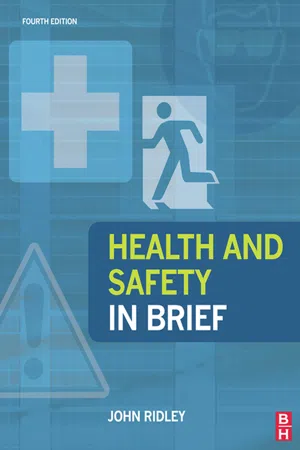
- 328 pages
- English
- ePUB (mobile friendly)
- Available on iOS & Android
Health and Safety in Brief
About This Book
In plain English, John Ridley guides the reader through Health and Safety legislation and explains how to comply with it in practical terms. The text is clearly laid out, distinguishing between bulleted summaries of legislative requirements and the author's advice and commentary.By condensing the fundamental contents of the author's acclaimed Safety at Work into a practical and affordable volume, Health and Safety in Brief has established itself as a valuable handbook for safety representatives and managers, as well as an essential revision aid for students on introductory health & safety and general management courses such as:
* NEBOSH National Certificate and Diploma in Occupational Safety and Health
* IOSH Managing Safely
* CIEH Advanced Certificate in Health & Safety in the Workplace
* British Safety Council Level 3 Certificate in Occupational Safety and Health
* NVQs in Occupational Safety and Health
* Chartered Management Institute's Level 5 Diploma in Management New in this edition:
* Completely revised coverage of fire safety in line with Regulatory Reform (Fire Safety) Order
* Construction safety incorporates new Construction (Design and Management) Regulations 2007 and new Working at Heights Regulations
* Coverage of changes in employment law, including age discrimination and working time
* More on the effects of the Woolf Report
Frequently asked questions
Alfred the Great | 871–901 |
|
Edgar | 959–975 |
|
Edward the Confessor | 1042–1066 |
|
William the Conqueror | 1066–1087 |
|
Stephen | 1135–1154 |
|
Henry II | 1154–1189 |
|
John | 1199–1216 |
|
Henry III | 1216–1272 |
|
Edward I | 1272–1307 |
|
- Statute law comprises those laws which are debated and made by Parliament. They are written and copies are available for all to purchase (from The Stationery Office (TSO)). Statute law is the law of the State and a breach of it is a criminal offence, hence it is sometimes referred to as criminal law.
- Common law originally referred to a system of law common across the whole country. However, its meaning has changed to encompass case law – the body of law based on judicial precedents, i.e. the decisions of judges in earlier cases are binding in similar later cases. It is not officially written but is recorded in Law Reports. Equity law supplements common law in that it deals with complaints against common law judgements where there may have been a distortion of justice, i.e. such as from undue influence by one party.
- Public law – dealing with matters involving the State and relating to the protection and well being of the public at large whether directly or indirectly. Typical of these laws are:
- constitutional laws
- employment laws
- social security laws
- criminal laws
- Private law – statutory requirements that deal with matters regulating the relationship between ‘private parties’ or ‘legal and natural bodies’ such as in:
- contracts
- torts
- property
- trusts
- succession
- Civil law – a generic term covering all laws except criminal laws.
- Law concerning the protection of the State, the community and the individual.
- Laws are passed or approved by Parliament.
- Written law, copies obtainable from TSO.
- A breach is a crime or criminal offence.
- Criminal proceeding (prosecution) heard: – in Magistrate’s Court for lesser cases– in Crown Court for more serious cases.
- Evidence must prove guilt ‘beyond reasonable doubt’.
- Common law action.
- Between two or more private or corporate bodies.
- Based on precedent set by judgements in earlier cases.
- Proceeding (litigation) heard in County Court.
Table of contents
- Cover Page
- Half Title Page
- Title Page
- Copyright Page
- Contents
- Preface
- Part 1: Law
- Part 2: Management
- Part 3: Occupational Health
- Part 4: Safety Technology
- Appendix 1 Abbreviations
- Appendix 2 List of statutes
- Index